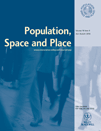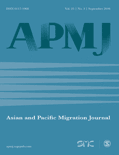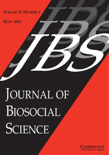
Papeles de Poblacion
Scope & Guideline
Fostering understanding through open-access research.
Introduction
Aims and Scopes
- Demographic Analysis and Trends:
The journal publishes research that delves into demographic changes, such as fertility rates, migration patterns, and aging populations, particularly in Latin America. This includes historical analyses and projections that inform public policy. - Social Inequality and Vulnerability:
A significant focus on social determinants of health and inequality, addressing issues such as poverty, gender disparities, and socio-economic stratification. Studies often explore how these factors intersect with demographic changes. - Migration Studies:
Research on migration, including the experiences of migrants, causes of migration, and the socio-economic impacts of migration flows on both sending and receiving countries. This includes irregular migration and the role of remittances. - Public Policy and Social Programs:
The journal provides insights into the effectiveness of social protection measures and public policies aimed at addressing demographic challenges, such as health care access, education, and labor market integration. - Cultural and Ethnic Dimensions:
Exploration of how cultural and ethnic factors influence demographic trends and social inequalities, including the impact of ethnicity on migration experiences and social integration.
Trending and Emerging
- Impact of Covid-19 on Demographics:
There is a growing body of research examining the effects of the Covid-19 pandemic on various demographic indicators, including mortality, health vulnerabilities, and migration patterns, highlighting the pandemic's lasting impact on population studies. - Gender and Labor Market Integration:
Increasing attention is being paid to gender disparities in labor market outcomes, particularly in the context of migration and return migration, reflecting a broader societal focus on gender equality. - Irregular Migration and Human Rights:
Emerging themes around irregular migration, human rights, and the socio-economic implications for both migrants and host countries are gaining traction, reflecting global migration trends and humanitarian concerns. - Cultural Narratives and Community Resilience:
Research emphasizing the role of cultural narratives in shaping demographic behaviors and community responses to social challenges is becoming more prevalent, indicating a shift towards qualitative and ethnographic approaches. - Social Protection Mechanisms:
An increased focus on social protection systems and their effectiveness in mitigating vulnerabilities, particularly for marginalized populations, suggests a growing interest in policy-oriented research.
Declining or Waning
- Traditional Fertility Studies:
Research focused solely on traditional fertility rates and demographic transition theories appears to be less prevalent, possibly overshadowed by more complex analyses that consider socio-economic and cultural factors. - Static Historical Demographic Comparisons:
Papers that strictly compare historical demographic data without addressing current implications or policy recommendations seem to be decreasing, as the journal shifts towards more applied research. - Generalized Economic Analysis:
There has been a noticeable reduction in publications that focus solely on economic analyses without linking them to demographic or social outcomes, indicating a preference for interdisciplinary approaches.
Similar Journals

Journal of International Migration and Integration
Advancing Interdisciplinary Insights on MigrationJournal of International Migration and Integration, published by Springer Heidelberg, is a prestigious scholarly journal that serves as a vital platform for advancing the field of migration studies. With a focus on the interdisciplinary dialogue among anthropology, cultural studies, and demography, this journal has achieved remarkable recognition, exemplified by its Q1 status in Anthropology and Cultural Studies, as well as its Q2 designation in Demography. With its ISSN 1488-3473 and E-ISSN 1874-6365, the journal provides exceptional insights into migration-related issues and integration processes across diverse global contexts. As of 2023, the journal ranks in the 91st percentile in Cultural Studies, the 83rd percentile in Anthropology, and the 71st percentile in Demography on Scopus, reflecting its significant impact on scholarly discourse. Researchers, professionals, and students engaged in the study of migration will find this journal an indispensable resource for contemporary research and innovative solutions in understanding the complexities of migration and integration.

JOURNAL OF ETHNIC AND MIGRATION STUDIES
Charting New Paths in Ethnic and Migration ResearchJOURNAL OF ETHNIC AND MIGRATION STUDIES (ISSN: 1369-183X, E-ISSN: 1469-9451) is a leading peer-reviewed journal published by Routledge Journals, Taylor & Francis Ltd, based in the United Kingdom. With a significant impact factor and ranked Q1 in both Arts and Humanities (miscellaneous) and Demography as of 2023, this journal is pivotal for advancing research in ethnic and migration studies. It brings together interdisciplinary perspectives, focusing on the complexities of migration, integration, and the dynamics of cultural diversity across the globe. The journal's commitment to high-quality scholarship is reflected in its impressive Scopus rankings, placing it in the top percentile for both Demography and Arts and Humanities categories. Although not currently open access, it provides essential insights for researchers, policymakers, and practitioners dedicated to understanding the ever-evolving landscape of ethnic relations and migration issues. With contributions that span from theoretical frameworks to empirical studies, the journal aims to foster a deeper understanding of the social implications of migration, making it an invaluable resource for scholars and students alike.

DEMOGRAPHY
Shaping the future through population studies.DEMOGRAPHY is a prestigious, peer-reviewed journal published by DUKE UNIVERSITY PRESS, dedicated to advancing the field of demography through scholarly research and critical discourse. With an esteemed Q1 ranking in Social Sciences and an impressive Scopus rank of #10 out of 139 in the category, this journal holds a 93rd percentile status, reflecting its significant impact on the academic community. Covering a wide range of topics related to population studies, including fertility, mortality, migration, and demographic change, DEMOGRAPHY serves as a vital resource for researchers, professionals, and students alike. Since its inception in 1964, it has provided a platform for innovative studies and influential articles that address both theoretical frameworks and applied research. Although not an open-access journal, it ensures that its contributions reach a global audience while maintaining rigorous academic standards. Engage with DEMOGRAPHY to explore and contribute to the dynamic discussions shaping our understanding of human populations in a complex world.

Central and Eastern European Migration Review
Pioneering Research on Migration Dynamics and Societal ChangeThe Central and Eastern European Migration Review, published by the CENTRE MIGRATION RESEARCH, University of Warsaw, serves as a critical platform for sharing innovative research on migration dynamics within Central and Eastern Europe. This Open Access journal has been a vital resource for scholars since its inception in 2012, enabling widespread access to high-quality research that addresses pressing demographic, social, and political issues related to migration. With an impressive ranking among the Q2 category in Demography, Social Sciences (miscellaneous), and Sociology and Political Science, it occupies a significant space in contemporary sociological discourse, reflecting its robust scholarly impact. Notably, the journal achieved Scopus rankings that place it in the 60th percentile or higher within multiple categories, highlighting its contributions to the field. Researchers, professionals, and students alike can delve into a diverse array of articles that explore migration trends, policies, and societal implications, making it an indispensable resource for anyone engaged in migration studies.

Population Space and Place
Advancing Insights in Demography and GeographyPopulation Space and Place is an esteemed academic journal published by WILEY, dedicated to advancing the fields of demography and geography, planning, and development. With an impressive 2023 impact factor and categorized in the top quartile (Q1) for both demography and geography, this journal serves as a vital platform for researchers, professionals, and students seeking to explore the spatial dimensions of population dynamics. Founded in 2004 and running through 2024, it has established itself as a significant contributor to scholarly discussions, evidenced by its high Scopus rankings, including rank #18 out of 139 in demography and #165 out of 821 in geography and planning. While the journal currently does not offer open access, it remains a key resource for those involved in academic research and policy formulation. With its focus on the interplay between population trends and spatial analytics, Population Space and Place is essential for anyone aiming to understand the complexities of population geography in a rapidly changing world.

Asian and Pacific Migration Journal
Elevating voices in the study of migration patterns.The Asian and Pacific Migration Journal is a premier scholarly publication dedicated to the critical examination of migration issues within the Asian and Pacific regions. Published by SAGE PUBLICATIONS LTD, this journal has played a pivotal role in advancing knowledge and understanding in the fields of demography and geography, evidenced by its recognition in the 2023 Category Quartiles as Q2 in Demography and Q3 in Geography, Planning and Development. Since its inception in 1992, the journal has sustained a commitment to providing high-quality, peer-reviewed articles that engage with contemporary migration challenges and trends, making it essential reading for researchers, professionals, and students alike. Although not open access, the journal continues to maintain a respectable Scopus rank in the social sciences, making significant contributions to academic discourse. As it moves towards 2024, the journal remains a vital resource for those seeking to deepen their understanding of migration dynamics in these critical regions.

JOURNAL OF BIOSOCIAL SCIENCE
Innovating Understanding of Health in Social ContextsJOURNAL OF BIOSOCIAL SCIENCE, published by Cambridge University Press, is a pivotal interdisciplinary journal dedicated to advancing our understanding of the complex interplay between biological and social factors in human health and society. With an ISSN of 0021-9320 and an E-ISSN of 1469-7599, this journal has been a cornerstone of scholarly communication since its inception in 1969, paving the way for innovative research until 2024 and beyond. The journal is ranked in the Q3 quartile in Public Health, Environmental and Occupational Health and Q2 in Social Sciences (miscellaneous), reflecting its significant impact in these fields. Its Scopus ranking further emphasizes its relevance, sitting at #79 out of 275 in General Social Sciences and #334 out of 665 in Public Health. Researchers, professionals, and students are encouraged to explore the journal's rich repository of articles that delve into critical biosocial issues, fostering a deeper understanding of how social structures influence health and well-being. Although not open access, the journal remains an essential resource for those committed to addressing contemporary health challenges through a biosocial lens.

Demografie
Fostering knowledge on the evolution of populations worldwide.Demografie is a distinguished academic journal published by the Cesky Statistical Office in the Czech Republic, serving as a vital platform for scholars and practitioners interested in the multifaceted field of demography. Established in 1976 and consistently contributing until 1999, with a renewed focus from 2014 to 2024, this journal engages with critical issues such as population dynamics, migration patterns, and socio-economic factors influencing demographic changes. For its impactful research contributions, it holds a Q3 category ranking in Demography for 2023, with a Scopus rank of #89 out of 139 in the Social Sciences category, reflecting its credibility and relevance in the field. Although it operates under traditional access, its insightful articles and comprehensive analyses remain valuable resources for researchers, professionals, and students eager to deepen their understanding of demographic trends and policies. The journal's commitment to advancing demographic knowledge makes it an essential read for those navigating the complexities of population studies.

JOURNAL OF POPULATION RESEARCH
Unveiling trends that shape our societies.JOURNAL OF POPULATION RESEARCH, published by Springer, is a premier journal dedicated to advancing the field of demographic studies. With a focus on research that addresses the complexities of population dynamics, this journal serves as a vital platform for scholars, practitioners, and students alike. It holds a commendable Q2 ranking in the Demography category for 2023, underscoring its influence and commitment to quality research. The journal spans a rich convergence of knowledge from 2005 to 2024, covering key developments and emerging trends in population research. Although it operates under a traditional access model, its impact continues to resonate throughout the academic community, highlighting the importance of robust demographic analysis in policy and planning. By fostering insightful discussions and providing access to groundbreaking studies, the JOURNAL OF POPULATION RESEARCH remains an essential resource for those eager to deepen their understanding of population issues.

Migraciones
Unveiling the Dynamics of Migration DiscourseMigraciones, an esteemed academic journal founded in 2012 and published by the UNIV PONTIFICIA COMILLAS MADRID, FAC FILOSOFIA, serves as a vital resource in the fields of Cultural Studies and Demography. With a commendable Q1 ranking in Cultural Studies and a strong presence in Demography (Q2), this journal boasts a significant impact in facilitating scholarly discourse and empirical research in migration issues. The journal has embraced an Open Access model since 2016, providing unrestricted access to its rich array of scholarly articles that critically examine the cultural implications and demographic dynamics of migration patterns globally. Migraciones not only showcases rigorous peer-reviewed research but also encourages interdisciplinary studies, making it an essential publication for researchers, professionals, and students seeking to deepen their understanding of migratory phenomena. For those interested, the journal is accessible under ISSN 1138-5774 and E-ISSN 2341-0833, based in Madrid, Spain.